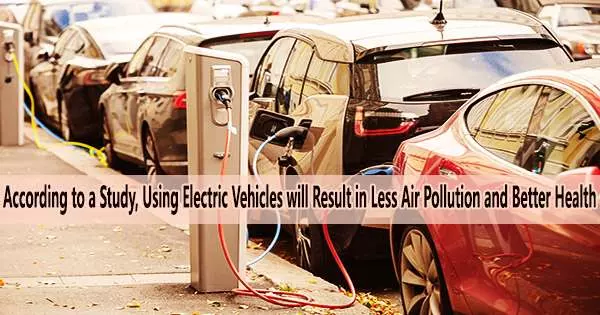Electric vehicles are frequently touted as a crucial tool for reducing emissions and combating climate change, but research on the twin advantages of lower air pollution and better health has been largely speculative.
In the first study to use real-world data to relate electric cars, air pollution, and health, a group of researchers from the Keck School of Medicine of USC have started to chronicle the actual impact of the adoption of electric vehicles.
The researchers examined a “natural experiment” taking place in California as citizens there quickly switched to electric cars, or light-duty zero emissions vehicles (ZEVs), using publicly accessible datasets. The results were just published in the journal Science of the Total Environment.
The team compared data on total ZEV registration, air pollution levels, and asthma-related emergency room visits across the state between 2013 to 2019. As ZEV adoption increased within a given zip code, local air pollution levels, and emergency room visits dropped.
“When we think about the actions related to climate change, often it’s on a global level,” said Erika Garcia, PhD, MPH, an assistant professor of population and public health sciences at the Keck School of Medicine and the study’s lead author. “But the idea that changes being made at the local level can improve the health of your own community could be a powerful message to the public and to policy makers.”
The researchers also discovered what they call the “adoption gap,” which is that while the overall number of ZEVs increased over time, adoption was more slower in low-resource zip codes. The opportunity to restore environmental justice in communities that are disproportionately impacted by pollution and related health issues is indicated by this gap.
“The impacts of climate change on health can be challenging to talk about because they can feel very scary,” said Sandrah Eckel, PhD, an associate professor of population and public health sciences at the Keck School of Medicine and the study’s senior author. “We’re excited about shifting the conversation towards climate change mitigation and adaptation, and these results suggest that transitioning to ZEVs is a key piece of that.”
When we think about the actions related to climate change, often it’s on a global level. But the idea that changes being made at the local level can improve the health of your own community could be a powerful message to the public and to policy makers.
Erika Garcia
Benefits for health and the climate
The research team examined and contrasted four distinct datasets in order to assess the effects of the adoption of electric vehicles. First, they obtained data on ZEVs (which includes battery electric, plug-in hybrid, and hydrogen fuel cell cars) from the California Department of Motor Vehicles and tabulated the total number registered in each zip code for every year between 2013 and 2019.
Also, they received information on zip code-level emergency department visits due to asthma from U.S. Environmental Protection Agency air monitoring sites on nitrogen dioxide (NO2) levels, a pollutant associated to traffic.
One of the health issues that has long been connected to air pollutants like NO2 is asthma. These pollutants can also worsen or cause other respiratory illnesses, as well as issues with the heart, brain, and other organ systems.
The researchers then determined the proportion of adults with bachelor’s degrees in each zip code. It is common practice to utilize educational degrees as a gauge of a neighborhood’s socioeconomic standing.
At the zip code level, for every additional 20 ZEVs per 1,000 people, there was a 3.2% drop in the rate of asthma-related emergency visits and a small suggestive reduction in NO2 levels. On average across zip codes in the state, ZEVs increased from 1.4 to 14.6 per 1,000 people between 2013 and 2019. ZEV adoption was significantly lower in zip codes with lower levels of educational attainment.
For example, a zip code with 17% of the population having a bachelor’s degree had, on average, an annual increase of 0.70 ZEVs per 1,000 people compared to an annual increase of 3.6 ZEVs per 1,000 people for a zip code with 47% of the population having a bachelor’s degree.
According to earlier studies, underprivileged populations, such as low-income neighborhoods, typically experience worse air pollution and related respiratory issues than more affluent places. If ZEVs replace gas-powered cars in those neighborhoods, they could stand to benefit substantially.
“Should continuing research support our findings, we want to make sure that those communities that are overburdened with the traffic-related air pollution are truly benefiting from this climate mitigation effort,” Garcia said.
More to learn
While climate change is a massive health threat, mitigating it offers a massive public health opportunity, Eckel said. The research, one of the first to assess the actual environmental and health advantages of ZEVs, can assist show the effectiveness of this mitigation strategy, including potentially lower healthcare utilization and costs.
The findings are promising, Garcia said, but many questions remain. Further research should take into account ZEVs’ extra effects, such as emissions related to brake and tire wear, material mining for their production, and vehicle disposal.
In addition to doing a follow-up study on the consequences of the state’s steadily increasing share of ZEVs, the researchers also aim to investigate new pollutant types and vehicle classifications.
“Moving forward, transitioning to ZEVs is just one part of the solution,” Eckel said. “Shifting to public transport and active transport, including walking and biking, are other key ways to boost environmental and public health.”
The University Of Southern California Office Of Research Strategic Directions supported this work for Research Award and the National Institute of Environmental Health Sciences.





